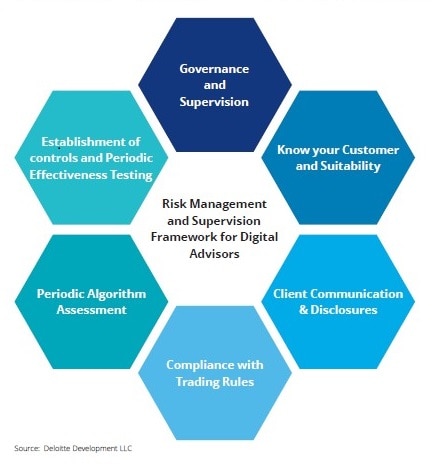Robo-advising platforms carry new risks has been saved

Perspectives
Robo-advising platforms carry new risks
Hands off—guard up
Robo-advising offers new opportunities for financial institutions. It also exposes them to new risks that shouldn’t be underestimated.
Robo advice for wealth and asset management firms
Various forms of technology have been adapted into a large portion of everyday life, and the financial industry is no exception. So it’s no surprise that a number of wealth and asset management firms have developed automated offerings of their own. Robo-advisers—systems that automate investment to match the target risk profile of an investor and execute investment decisions that optimally shape a portfolio—are growing in both number and capabilities.
Based on a 2016 study, Future of Wealth in the United States, which was conducted by the Deloitte Center for Financial Services, Deloitte estimates that the $2 billion in assets under automated management today may grow to $5 trillion to $7 trillion by the year 2025. While this won’t approach the $18 trillion currently managed by traditional advisers, robo-advising will clearly no longer be a fringe or experimental part of the market.
Robo-advising opens new frontiers in analytics, customer satisfaction, and fiduciary responsibility. But it also exposes institutions to new risks they shouldn’t underestimate, including:
- Regulatory risks
- Business risks
- Operational risks
- Technology risks
- Client expectations
Regulatory risks
To serve clients efficiently, a robo-adviser must be programmed with investment goals and equipped to capture and quantify the details of each investor’s risk profile. And to satisfy the investment adviser’s fiduciary responsibility, the robo-adviser environment must incorporate new controls and verification. For regulators, determining how to evaluate a software platform whose fiduciary responsibilities still ultimately reside with humans can be a challenge.
Business risks
Moving clients from human-based to technology-based experiences introduces risks such as low adoption and increased inquiries. In addition, the inability of the robo-adviser platform to better capture a client’s risk tolerance than a human financial adviser may lead to misalignment in asset allocations or conflicts of interest based on fees. Automated questionnaires may not account for behavioral biases.
Operational risks
Firms need to establish adequate controls around their automated adviser environments to mitigate risks involving customer segmentation, business continuity planning, and IT governance. It’s also important to guard against algorithm alteration or tampering that might bias investment advice or cause the algorithm to enact steps not aligned with a client’s best interests. Finally, client interaction itself is an important focus: Robo advice is meant to advance the client experience, but it can add client experience challenges as well.
Technology risks
To play a more central role in the disposition of clients’ assets, the IT control environment needs adequate levels of integrity, security, resiliency, and capacity. Recognizing and managing risks that arise from third-party providers is also critical. For example, the inability of the robo-adviser to adapt to increasing business volumes or ineffective planning for added capacity may result in revenue and customer loss. If a firm plans to leverage a vendor robo-adviser, it’s important to recognize and manage risks that can arise from the vendors.
Client expectations
Customer service is central to robo-advising. Institutions must maintain an environment in which every investor can expect a seamless, consistent experience, no matter how a transaction is handled or by whom. The client’s risk profile and other particulars should inform each delivery channel in the same way.
Mastering uncertainty to reap new rewards
In confronting the complex array of new risks that come with robo advice, firms may first be drawn to specific problems and point solutions. But the initial step should be comprehensive—to surround the entire undertaking with a “scaffold” in the form of a robust risk management framework. This should be a purpose-built approach, not simply a retooled version of the risk management regime that worked in the pre-digital era. It should also include the elements shown below.
Risk management framework for robo-advisers
Managing the risks inherent with robo-advising necessarily covers multiple dimensions. It spans such phases as due diligence, integration with the existing business, and ongoing monitoring of both operational effectiveness and regulatory compliance. As with any risk management regime, the approach to robo-advising should be more than a defensive stance. It should be a strategy to find the opportunities for heightened performance that risk taking makes possible.
Download Hands off-guard up: For wealth and asset management firms, “robo-advising” platforms carry new risks to read the full report in PDF form.
Recommendations
Data challenges in wealth management
Capitalizing on the underlying opportunity
Effecting behavior change in a world of automated financial advisors
A Deloitte Insights essay




